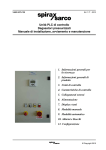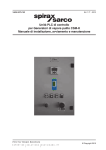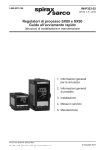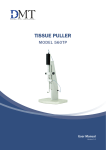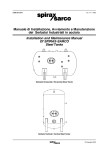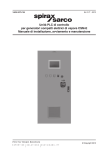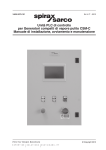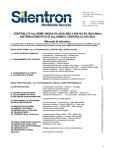Download Unità comando motori MDU100 Manuale di installazione
Transcript
3.589.5275.910 Ed. 2 IT - 2006 Unità comando motori MDU100 Manuale di installazione, operazione e manutenzione Motor drive unit MDU100 Installation, Operation, and Maintanance Manual © Copyright 2006 ATTENZIONE Lavorare in sicurezza con apparecchiature in ghisa e vapore Working safely with cast iron products on steam Informazioni di sicurezza supplementari - Additional Informations for safety Lavorare in sicurezza con prodotti in ghisa per linee vapore I prodotti di ghisa sono comunemente presenti in molti sistemi a vapore. Se installati correttamente, in accordo alle migliori pratiche ingegneristiche, sono dispositivi totalmente sicuri. Tuttavia la ghisa, a causa delle sue proprietà meccaniche, è meno malleabile di altri materiali come la ghisa sferoidale o l’acciaio al carbonio. Di seguito sono indicate le migliori pratiche ingegneristiche necessarie per evitare i colpi d'ariete e garantire condizioni di lavoro sicure sui sistemi a vapore. Movimentazione in sicurezza La ghisa è un materiale fragile: in caso di caduta accidentale il prodotto in ghisa non è più utilizzabile. Per informazioni più dettagliate consultare il manuale d'istruzioni del prodotto. Rimuovere la targhetta prima di effettuare la messa in servizio. Working safely with cast iron products on steam Cast iron products are commonly found on steam and condensate systems. If installed correctly using good steam engineering practices, it is perfectly safe. However, because of its mechanical properties, it is less forgiving compared to other materials such as SG iron or carbon steel. The following are the good engineering practices required to prevent waterhammer and ensure safe working conditions on a steam system. Safe Handling Cast Iron is a brittle material. If the product is dropped during installation and there is any risk of damage the product should not be used unless it is fully inspected and pressure tested by the manufacturer. Please remove label before commissioning Prevenzione dai colpi d’ariete - Prevention of water hammer Scarico condensa nelle linee vapore - Steam trapping on steam mains: Intervalli di 30÷50 m. intervals Penden za - Gra Vapore Steam dient 1:1 00 Gruppo di scarico Trap set Condensa - Condasate Esempi di esecuzioni corrette ( Steam Mains - Do's and Dont's: Flusso Flow Vapore Steam Penden za - Gra dient 1:1 00 Gruppo di scarico Trap set Condensa - Condasate ) ed errate ( Flusso Flow Vapore Steam Gruppo di scarico Trap set Condensa - Condasate ) sulle linee vapore: Prevenzione delle sollecitazioni di trazione Prevention of tensile stressing Evitare il disallineamento delle tubazioni - Pipe misalignment: Installazione dei prodotti o loro rimontaggio post-manutenzione: Installing products or re-assembling after maintenance: Evitare l’eccessivo serraggio. Utilizzare le coppie di serraggio raccomandate. Do not over tighten. Use correct torque figures. Per garantire l’uniformità del carico e dell'allineamento, i bulloni delle flange devono essere serrati in modo graduale e in sequenza, come indicato in figura. Flange bolts should be gradually tightened across diameters to ensure even load and alignment. Dilatazioni termiche - Thermal expansion: Gli esempi mostrano l’uso corretto dei compensatori di dilatzione. Si consiglia di richiedere una consulenza specialistica ai tecnici dell’azienda che produce i compensatori di dilatazione. Examples showing the use of expansion bellows. It is highly recommended that expert advise is sought from the bellows manufacturer. Guide Guides Movimento assiale Axial movement Distanza breve Short distance Punto di fissaggio Fixing point Movimento assiale Axial movement Guide Guides Guide Guides Tiranti limitatori Limit rods Distanza media Medium distance Piccolo movimento laterale Small lateral movement Ampio movimento laterale Large lateral movement Punto di fissaggio Fixing point Tiranti limitatori Limit rods Guide Guides Piccolo movimento laterale Small lateral movement Ampio movimento laterale Large lateral movement INDICE / TABLE OF CONTEST Descrizione unità comando motore / Motor drive unit description 3 Identificazione componenti / Component and location 1. Sezionare alimentatore di rete / Power disconnect device 2. Indicatore a led L1 / Led indicator L1 3. Indicatore a led L2 / Led indicator L2 4. Selettori / Selector 5. Posizionatore e logica / Positioner and logics - Indicatori a led (dettaglio) / Led indicators (details) - Potenziometri di taratura / Calibration potentiometers - Interruttori / DIP switches 6. Alimentatore / Power supply 7. Relè KR, K3 8. Portafusibili / Fuses holder 9. Relè comando motori K1, K2 / Motor drive relays K1, K2 10. Relè termico di protezione RT / Thermal relay RT 11. Alimentatore - Convertitore / Power supply - Converter 12. Morsettiera / Terminals 3 3 4 4 4 5 6 6 7 7 7 8 8 8 8 9 Installazione / Installation 9 Collegamenti dei cavi di potenza e del cavo di massa / Installation groun input power wiring 9 Collegamenti unità ai motori delle valvole / Installing output wiring to the valve actuator Verifica dell’installazione / Checking the installation Schemi di collegamento tra l’unità e il motore (SG1, SG2, SG3) / Electrical connections between the unit and motor (SG1, SG2, SG3) 10 - 12 13 14 -17 Tarature / Calibration 18 Impostazione dei DIP switches / DIP switches positions and settings 18 Ricerca guasti / Trouble shooting 19 Ricambi / Spare parts 20 2 3.589.5275.910 MDU100 Descrizione unità comando motore MDU100 motor drive unit description L’unità di comando motore è l’unità di comando e controllo della famiglia dei motori SG per comando valvole rotative. L’unità riceve il segnale 4-20 mA di controllo esterno da computer/PLC o regolatore e controlla la posizione della valvola ritrasmettendo un segnale di posizione valvola 4-20 mA. The MDU drive unit provide a positive means to drive and control the SG family actuators for rotary valves. It receives a 4-20 mA from an external computer/PLC or controller to control the position and retransmit a 4-20 mA valve position signal to computer/PLC or controller. Fig. 1 MDU100 - Identificazione componenti. MDU100 - Component and locations. L’unità MDU100 comprende i seguenti componenti principali: I numeri di identificazione corrispondono ai numeri usati nella fig. 2. Le parti di ricambio sono indicate a pag. 18. The MDU100 has the following main components. The identification numbers provided correspond to the number used in fig. 2. Replacement parts are listed at pag. 18. 1. 1. Sezionatore alimentazione di rete Power disconnect device E’ un sezionatore porta manuale tripolare con maniglia blocco porta che interrompe le 3 fasi di alimentazione e consente l’apertura della porta solo quando è in posizione di “OFF”. Quando è in posizione di “ON” consente di alimentare l’unità. The power disconnect device is a circuit breaker that breaks the 3 phase input power supply that allows to open the cabinet door only when is in “OFF” position. When is in “ON” position it powers the unit. Attenzione: Solo personale qualificato che conosce i problemi ed i pericoli connessi ad apparecchiature di questo tipo dovrebbe installare, operare o manutenere questi apparecchi. Leggere e capire il manuale, ed altri manuali collegati, nella loro completezza prima di procedere. In caso di inosservanza si possono provocare danni a cose o persone. Attention: Only qualified electrical personnel familiar with operation of this equipment and the hazards involved should install, adjust, operate, or service this equipment. Read and understand this manual and other applicable manuals in their entirely before proceeding. Failure to observe this precaution could result in severe bodily injury or loss of life. Attenzione: L’utilizzatore deve installare un circuito esterno di interruzione dell’alimentazione elettrica. Questo circuito deve poter interrompere l’alimentazione all’MDU100 in caso di errate operazioni o per manutenzione sull’unità. Se non viene fatto si creeranno condizioni di pericolo per il personale addetto. Attention: The user must provide an external, stop circuit outside of the drive circuitry. This circuit must disable the system in case of improper operation and maintenance. Failure to observe this precaution could result in bodily injury. ∆ ∆ 3.589.5275.910 ∆ ∆ 3 2. Indicatore a led L1 2. Led indicator L1 Quando è acceso (luce bianca) indica che l’unità è alimentata. When (white light) is on indicate power ON. 3. 3. Indicatore a led L2 Led indicator L2 Quando è acceso (luce gialla) indica che l’unità MDU100 è fuori sevizio. When (yellow light) is on indicate that there is a system failure in the MDU100. 4. 4. S1 S2 - Selettori E’ un selettore con tre posizioni stabili per selezionare: Controllo locale. Controllo remoto. O usato per interventi sull’unità. E’ un selettore, a tre posizioni con ritorno al centro per il comando manuale della valvola per aumentare o diminuire la temperatura del fluido controllato. S1 S2 - Selectors Is a three stable position selector to select the: Local control. Remote control. O used to tune the unit. Is a three position selector with return to the central position to drive locally the valve in order to increase or decrease the controlled fluid temperature. Porta frontale/Front cover Sezionatore alimentazione di rete 1 Power disconnect device 3 L2 Indicatore L1 Indicatore 2 L1 Indicator L2 Indicator Etichetta/Label S1 Selettore/Selector 4 S2 Selettore/Selector Porta fusibili/Fuses folder 8 Sezionatore alimentazione di rete 1 Power disconnect device 7 Relè KR, K3/Relays KR, K3 6 Alimentatore/Power supply Alimentazione a 5Vcc 11 5Vdc power supply Relè comando motori 9 Motor drive relays 10 Relè termico/Thermal relay 12 Morsettiera/Terminals 5 Posizionatore e logica/Positioner and logics Fig. 2 4 3.589.5275.910 5. Posizionatore e logica 5. Positioner and logics La funzione di logica e controllo dell’unità viene attuata da un microprocessore montato sul posizionatore (fig. 3) che: Modo remoto L’unità posizionatore riceve i 4-20 mA dall’unità di controllo esterno (calcolatore, PLC o regolatore) confronta il segnale di comando con il segnale di posizione valvola, fornito dal potenziometro montato sul motore della valvola, e quando i segnali non sono uguali l’unità alimenta il motore elettrico per modificare la posizione della valvola, fino a che i due segnali non siano diventati uguali. L’unità invia anche il segnale di posizione valvola (4-20 mA) al calcolatore/PLC od indicatore esterno. Modo locale L’unità permette di muovere la valvola in direzione di aumento di temperatura del fluido controllato o in diminuzione della temperatura del fluido controllato. The logic and control function is performed by a microprocessor on the positioner board. (fig. 3) that provides: Remote mode The positioner board accepts the 4-20 mA from external computer/PLC or single controller compares to the analog control signal with a voltage from the valve position feedback potentiometer and when the signals are not equal, sends volts AC to the motor to change the valve position until the signals become equal. The unit also sends 4-20 mA, indicating valve position to outside computer/PLC or indicators. Local mode The unit allows to drive the valve in order: To “increase” the temperature of the controlled fluid. To “decrease” the temperature of the controlled fluid. In aggiunta il posizionatore fornisce: In addition the positioner logies provides: Allarme in caso di guasti - Controllo continuo di: - Tensione - Limiti di fine corsa - Limiti di coppia - Indicatori di start a led - Potenziometri di taratura - Interruttori per circuiti stampati Automatic alarm for failure conditions - Continuos control of: - Voltages - Travel limit switch - Torque limits - Led indicators - Potentiometers for calibration - DIP switches Fig. 3 3.589.5275.910 5 Indicatori a led (dettaglio A) Leds indicators (detail A) (ON = ACCESI) (ON = LIGHTS) LED 1 - (Verde) ACCESO = Sistema funzionante LED 1 - (Green) ON = The unit is working (no failure) LED 2 - (Rosso) Posizione del selettore locale/remoto ACCESO - Selettore su posizione “Remoto” SPENTO - Selettore in posizione centrale INTERMITTENTE - selettore su posizione “Locale” LED 2 - (Red) Position of local/remote selector. ON - Selector on “Remote” position OFF - Selector on central position FLASHING - Selector on “local” position LED 3 - (Giallo) ACCESO = Il termico del motore (Th) è intervenuto per surriscaldamento del motore. In questo caso l’attuatore viene bloccato e viene segnalata un’anomalia. Per ripartire sarà necessario che la temperatura del motore scenda sotto il limite previsto. INTERMITTENTE (1 Hz): Problemi su set point di posizione INTERMITTENTE VELOCE (4 Hz): Problemi sul segnale di “feedback” LED 3 - (Yellow) ON = Motor thermoswitch (Th) is opened because the temperature of the motor is increased beyond a permissible limit. In this case the actuator is stopped and a thermal fault is given. To restart it will be necessary that the temperature return under the limit FLASHING (1 Hz): Problem on position set point FAST FLASHING (4 Hz): Problem on feedback signal LED 4 - (Rosso) ACCESO = Valvola in posizione aperta INTERMITTENTE = Valvola comandata in apertura LED 4 - (Red) ON = Valve to the OPEN LIMIT position FLASHING = Valve moving towards the OPEN position LED 5 - (Rosso) ACCESO = Valvola in posizione chiusa INTERMITTENTE = Valvola comandata in chiusura LED 5 - (Red) ON = Valve to the CLOSE LIMIT position FLASHING = Valve moving towards the CLOSE position Nota: Se i leds 2,3,4,5 sono tutti accesi ed il led 1 è spento c’è un guasto sulla carta del posizionatore ed in queste condizioni sono solo possibili le operazioni manuali. Note: If leds 2,3,4,5 are ON and Led 1 is OFF there is a failure on the boards and only the manual operation of the valve is possible. ∆ 1 Led Verde/ Green ∆ 2 3 4 5 Led Led Led Led Rosso/ Giallo/ Rosso/ Rosso/ Red Yellow Red Red Dettaglio A Detail A Potenziometri di taratura (dettaglio B) Calibration potentiometers (detail B) Ci sono 6 potenziometri sul fronte della carta del posizionatore che permettono i seguenti aggiustamenti: PT3 = Taratura dello zero del segnale analogico di posizione (4 mA) (aumenta in senso orario). PT4 = Taratura del guadagno del segnale analogico di posizione (aumenta in senso orario). PT5 = Taratura di posizione valvola chiusa (0-50%) (orario verso valvola aperta). PT6 = Taratura di posizione valvola aperta (50-100%) (orario verso valvola aperta). PT7 = Taratura della banda morta (1/6% della corsa) (aumenta in senso orario). PT8 = Taratura del tempo pausa di inversione (0,4-10 secondi) (aumenta in senso orario). There are 6 potentiometers situated on the front of the positioner board to allow following adjustments: PT3 = Calibration of the zero of the analog output signal (4 mA) (clockwise increase). PT4 = Calibration of the gain of analog output signal (clockwise increase). PT5 = Calibration of the close limit position of the valve (050%) (clockwise towards valve opened). PT6 = Calibration of the open limit position of the valve (50100%) (clockwise towards valve opened). PT7 = Calibration of dead band (1/6% of the full valve travel) (clockwise increase). PT8 = Calibration of the time to invert the motor direction (0,410 seconds) (clockwise increase). PT 4 Dettaglio B 6 PT 3 PT 8 PT 7 PT 6 PT 5 Detail B 3.589.5275.910 Interruttori (dettaglio C) D.SW 1 DIP switches (detail C) D.SW 1 OFF = Il segnale di comando valvola è diretto: 4 mA per valvola chiusa. 20 mA per valvola aperta. ON = Il segnale di comando valvola è inverso: 4 mA per valvola aperta. 20 mA per valvola chiusa. OFF = The signal from computer/PLC is normal: 4 mA for closed valve. 20 mA for opened valve. ON = The signal from computer/PLC is reverse: 4 mA for opened valve. 20 mA for closed valve. D.SW 2 D.SW 2 OFF = La valvola sarà bloccata in posizione in caso di errore di set point. ON = La valvola sarà forzata in apertura in caso di errore di set point. OFF = The valve will be blocked in the actual position in case of set point failure. ON = The valve will be forced the open position in case of set point failure. D.SW 3 D.SW 3 OFF = La valvola sarà bloccata in posizione in caso di errore di set point. ON = La valvola sarà forzata in chiusura in caso di errore di set point. OFF = The valve will be blocked in the actual position in case of set point failure. ON = The valve will be forced to the closed position in case of set point failure. D.SW 4 D.SW 4 OFF = La valvola sarà bloccata in posizione in caso di errore nel segnale di feedback. ON = La valvola sarà forzata in apertura in caso di errore nel segnale di feedback. OFF = The valve will be blocked in position in case of feedback signal failure. ON = The valve will be forced to open position in case of feedback signal failure. D.SW 5 D.SW 5 OFF = La valvola sarà bloccata in posizione in caso di errore nel segnale di feedback. ON = La valvola sarà forzata in chiusura in caso di errore nel segnale di feedback. OFF = The valve will be blocked in position in case of feedback signal failure. ON = The valve will be forced to close in case of feedback signal failure. D.SW 6 D.SW 6 OFF = Il selettore INCREASE/DECREASE è del tipo ad impulsi. ON = Il selettore INCREASE/DECREASE è con ritenuta. OFF = External INCREASE/DECREASE selector is of impulse type. ON = External INCREASE/DECREASE selector is with retention. D.SW 7 D.SW 7 Non usato. Not used. D.SW 8 D.SW 8 OFF = Durante il funzionamento normale. ON = Durante il processo di impostazione e lettura dati. OFF = In operation condition. ON = Calibration and setting. Dettaglio C 6. Detail C Alimentatore 6. Power supply Alimentatore 24V/30VA di potenza per alimentare lampade, relè e contatti (fig. 4) 30 VA supply to power lamps, relays and contacts (fig. 4) 7. 7. Relè KR, K3 KR: Relè di stato remoto K3: Relè dello stato di allarme Relays KR, K3 KR: Remote command relay K3: Alarm relay 7 6 Fig. 4 3.589.5275.910 7 8. 8. Portafusibili FG (10,3 x 38) Fuses holder FG (10,3 x 38) Portafusibili trifase che alloggia: Per motori SG1 = Fusibili da 6 A. Per motori SG2 = Fusibili da 6 A. Per motori SG3 = Fusibili da 10 A. 3 phases main power fuses holder. Fuses are: For SG1 motor = 6 Amperes. For SG2 motor = 6 Amperes. For SG3 motor = 10 Amperes. F1 = Portafusibili bifase con fusibili da 2 Amperes. F1 = 2 phases fuses holder. Fuses are of 2 Amperes. F2 = Portafusibile monofase che alloggia un fusibile da 1 Ampere. F2 = Single phase power fuse holder with 1 Ampere fuse. Fig. 5 Portafusibili FG, FU1, FU2 9. Fig. 5 Fuses holder FG, FU1, FU2 Relè di comando K1, K2 9. Relè comando motori con interblocco meccanico. 10. RT Relè termico Relè termico di protezione SG1 SG2 SG3 10. 440 V 0,22/0,32 0,7/1,0 1,2/2,5 Command relay K1, K2 Motor drive relays with mechanical block. 220 V 0,35/0,5 1,4/2,0 3,5/5,0 RT Thermal relay Thermal relay SG1 SG2 SG3 440 V 0,22/0,32 0,7/1,0 1,2/2,5 220 V 0,35/0,5 1,4/2,0 3,5/5,0 9 K1, K2 10 RT Fig. 6 Relè 11. Fig. 6 Relay Alimentatore convertitore Alimentatore del potenziometro di posizione valvola e convertitore del segnale di ritrasmissione di posizione. Posizione switch SL1: C = Uscita 4 - 20 mA passiva N = Uscita 4 - 20 mA attiva 11. Power supply - Signal converter Power supply for valve position potenziometer, position signal converter SL1 switch position: C = passive 4 - 20 mA output N = active 4 - 20 mA output SL1 Fig. 7 8 3.589.5275.910 12. Morsettiera 12. Terminals QG MG Ingresso alimentazione generale quadro Power supply input Massa / Ground QG M2 Massa / Ground Uscita alimentazione trifase valvola 3 phase valve power supply output QG M1 Contatto relè termico/Thermal relay contact Fine corsa apertura/Open limit switch Fine corsa chiusura/Closed limit switch Contatto coppia massima/Torque limit switch Contatto coppia massima/Torque limit switch Cursore potenziometro/Potentiometer cursor Uscita 4-20 mA/Output 4-20 mA Ingresso 4-20 mA/Input 4-20 mA Contatto relè remoto/Remote relay contact Fig. 8 Installazione Installation Montaggio dell’unità MDU100 Dimensioni: 500x400x250 Installare l’unità su una parete verticale usando i 4 occhielli previsti sul quadro. Per avere una superficie piana di appoggio ed assicurarsi della tenuta dei bulloni, usare delle rondelle. Mounting the MDU100 cabinet Dimensions: 500x400x250 Attach the unit to the vertical surface selected using the four (4) mounting holes provided on MDU 100 cabinet. In order to maintain a flat mounting surface and to ensure that bolt tightness is maintained, use washers under the bolt heads. Area L’area di installazione deve essere libera da cavi o altro. Verificare che l’unità sia mantenuta pulita, fredda ed asciutta. L’area scelta deve avere spazi sufficienti per il passaggio dell’aria e per la manutenzione. Site The installation site must be kept clear of all cables. Verify that MDU100 can be kept clear, cool and dry. The area chosen should allow the space required for air flow and for maintenance. E’ importante conoscere le dimensioni dei fori da fare sull’unità, in modo da poter alloggiare i cavi necessari. It is important to determine the size of the conduit openings so that the wire planned for a specific entry point will feet through the opening. Attenzione: l’utilizzatore è responsabile dell’installazione dei passacavi e dei fori sull’unità. Attention: the user is responsible to install the conduits openings and the cable conduits. Attenzione: non far passare i cavi dei segnali e di controllo insieme, con i cavi di potenza. Ciò può causare disturbi sul comando motore. In caso di inosservanza si possono avere dei danni all’apparecchiatura. Attention: Do not route signal and control wiring with power wiring in the same conduit. This can cause interference with drive operation. Failure to observe this precaution could result in damage to, or destruction of, the equipment. Collegamenti dei cavi di potenza e del cavo di massa Installation ground input power wiring Attenzione: L’utilizzatore deve installare un’interruttore di potenza a monte dell’unità MDU100. L’interruttore o sezionatore utilizzato dovrà interrompere 16 Ampere. E’ importante verificare che l’alimentazione principale sia quella richiesta dall’unità MDU100, assicurandosi, che corrisponda ai dati di tensione e frequenza, riportati sulla targhetta sul fronte dell’unità. Attention: a power disconnect device must be installed by the user, between the general power line and the MDU100. If the power disconnecting device is a circuit breaker, the circuit breaker must be able to trip 16 Amperes. It is important to verify that the main power will meet input power requirements of the MDU100. Be sure that input power corresponds to the MDU100 nameplate voltage and frequency. Attenzione: I cavi non usati devono essere messi a terra in entrambi i lati, per evitare problemi dovuti a tensioni indotte. Attention: unused wires in conduit must be grounded at both ends to avoid a possible shock hazard caused by induced voltages. ∆ ∆ ∆ ∆ 3.589.5275.910 ∆ ∆ ∆ ∆ 9 Collegamenti unità MDU100 ai motori delle valvole Installing output Wiring from MDU100 output terminals to the valve actuators Seguire i passi indicati per collegare l’unità MDU100 al motore della valvola ed al calcolatore/PLC o regolatore. Passo 1: aprire la porta dell’unità. Passo 2: rimuovere il coperchio dell’unità di controllo del motore della valvola. Passo 3: forare la piastra per il passaggio cavi e pressacavi in modo da far passare i cavi previsti. Use following steps to connect MDU100 to the valve motor and to computer/PLC or controller. Step 1: open the MDU100 door. Step 2: remove the electrical enclosure cover on the valve motor control. Step 3: prepare the conduits openings on the MDU100 plates so that the wires planned will feet through the openings. Attenzione: l’utilizzatore è responsabile della preparazione della piastra con relativi fori, pressacavi e cavi per il collegamento tra l’unità di controllo ed il motore della valvola. Passo 4: installare i pressacavi ed i cavi relativi sigillati in modo da rendere stagna l’entrata cavi sia sull’unità MDU100 che sul motore. Passo 5: installare i necessari multicavi dall’unità MDU100 al motore. Attention: the user is responsible to install the conduits openings, the cable conduits and the cable between MDU100 and the motor. Step 4: insert proper cable plugs with proper thread sealant ensuring waterproof protection and screw them tightly on MDU100 and on the motor cable entry plugs. Step 5: run multicore cables from MDU100 cabinet and the valve. Attenzione: i cavi di potenza e di massa non devono essere inferiori a 15 AWG mentre i cavi di segnale e di basso livello non devono essere inferiori a 18 AWG. Passo 6: collegare i cavi numerandoli ai terminali numerati dell’unità MDU100 e dalla parte opposta ai relativi terminali numerati sul motore secondo gli schemi elettrici da pag. 12 a pag. 15. Passo 7: collegare i cavi (possibilmente schermati) dei segnali di “set” e di posizione (4-20 mA) ai relativi morsetti numerati dell’unità MDU100 e dalla parte opposta al calcolatore/PLC o regolatore. Attention: power cables and ground must not be less than 15 AWG while signal cables must be, at least, of 18 AWG. Step 6: connect the wires on the numbered terminals of the MDU100 and in the numbered terminals of the motor according to the wiring from pag. 12 to pag. 15. Step 7: connect the wires on the numbered terminals (4-20 mA) of the MDU100 and on the corresponding computer/PLC or controller. Attenzione: l’utilizzatore è responsabile a che l’installazione sia eseguita secondo le normative locali, nazionali ed internazionali. La non applicazione di tali norme può danneggiare l’apparecchiatura. Attention: the user is responsible for conforming with all applicable local, national international codes. Failure to observe this precaution could result in damage to the equipment. ∆ ∆ ∆ ∆ ∆ ∆ Alimentazione/Power supply 230V 60Hz trifase/3phases FU1 FU2 Motore/Motor Mod. SG1 - SG2 85 ÷ 120 Watt Fig. 9 Alimentazione motori SG1 - SG2 10 Fig. 9 Electric power of SG1 - SG2 actuators 3.589.5275.910 Alimentazione/Power supply 230V 60Hz trifase/3phases FU1 FU2 Motore/Motor Mod. SG3 450 Watt Fig. 10 Alimentazione motore SG3 3.589.5275.910 Fig. 10 Electric power of SG3 actuator 11 Fig. 11 MDU100 - Schemi elettrici Fig. 11 MDU100 - Electric drawings Fig. 12 MDU100 - Schemi elettrici Fig. 12 MDU100 - Electric drawings 12 3.589.5275.910 Completare l’installazione Completing the installation Questo capitolo fornisce istruzioni su come effettuare una verifica finale prima di alimentare l’unità. This chapter provides instructions on how to perform a final check of the installation before power is applied. Attenzione: solo personale elettrico qualificato che ha esperienza su impianti analoghi deve operare sul sistema. Attention: only qualified electrical personnel familiar with the construction and operation of this equipment and the hazards involved should operate on the unit. Verifica dell’installazione Checking the installation Usare le procedure seguenti: - Rimuovere ogni elemento estraneo da ed intorno all’unità MDU100. - Verificare che ci sia sufficiente spazio intorno. - Verificare che i cablaggi siano corretti. - Verificare che le dimensioni dei cavi siano corrette e che siano correttamente fissati ai terminali. - Verificare se sono installati i circuiti di protezione e che siano dimensionati correttamente. - Verificare che la tensione di alimentazione sia corretta. - Verificare che sia installato un cavo di terra e che non sia interrotto. Use the following procedure to verify the condition of the installation: - Remove any debris, such as metal shavings, from around the MDU100. - Check that there is adequate clearance around. - Verify the wiring to the terminal strip and the power terminals is correct. - Check that the wire size is within specification and that the wires are tightened properly. - Check that circuit protection is installed and correctly rated. - Check that the incoming power is rated correctly. - Verify that a properly-sized ground wire is installed and a suitable earth ground is used. - Verify that all ground leads are unbroken. ∆ ∆ Attenzione: il circuito di controllo è al potenziale di linea quando è alimentato. Utilizzare un cacciavite non metallico quando si interviene sui circuiti e sui potenziometri. La inosservanza di tali precauzioni rappresenta un pericolo per persone e cose. ∆ ∆ Attention: the control circuit is at line potential when the drive is energized. Use a non-metallic screwdriver when making adjustment to the circuit board potentiometers. Exercise extreme caution as hazardous voltage exists. Failure to observe these precautions could result in severe bodily injury. La Spirax-Sarco certifica che l’unità MDU100 risponde a tutti i requisiti previsti dalla normativa “CE” come riportato sulla targhetta di identificazione. Spirax-Sarco hereby certifies that the MDU100 drive unit has been approved to bear the “CE” mark provided the conditions of approval have been met by the end user. The compliance allows MDU100 unit to bear the “CE” mark. Alimentare l’unità dopo l’installazione Powering up after installation is complete Usare la seguente procedura per verificare che l’unità MDU100 ed il motore siano installati ed alimentati correttamente. Mettere il sezionatore di linea dell’MDU100 su posizione “ON”. Posizionare il selettore locale/remoto su “locale”. Spostare il selettore decrease/increase su posizione “decrease” per aprire la valvola. Ricordarsi che la valvola è chiusa quando non occorre raffreddare il fluido controllato. Se il comando “decrease” fa chiudere la valvola interrompere la manovra ed invertire le due fasi dell’alimentazione sulla morsettiera dell’unità MDU100. Spostare il selettore su posizione “increase” e verificare che la valvola stia chiudendo. Use the following procedure to verify that the MDU100 and the motor are installed correctly and are receiving the proper line voltage: Turn motor drive unit input power disconnect to the “ON” position. Turn the local/remote switch on motor drive unit to local position. Press the decrease switch on motor drive unit to open and verify that the valve moves to the open position. Remember the valve is closed when it is not necessary to cool the controlled fluid. If the decrease control signal causes the closure of the valve, stop the operation and invert two phases of the supply line (only for 3phases motor) on the MDU100 unit. Press the increase switch on motor drive unit to close the valve and verify that the valve moves to the closed position. Sistema in operazione Operation Il modo operativo della valvola, a meno che non venga modificato in campo, è indicato sulla targhetta della valvola ed è secondo l’applicazione richiesta. Nei modi c,d la valvola apre per rotazione oraria mentre nei modi a,b la valvola apre per rotazione antioraria. Posizionare il selettore locale/remoto su “locale”. Portare la valvola in completa apertura e chiusura verificando che intervengano i relativi fine corsa. Se non intervengono riferirsi al manuale operativo dei motori SG per tarare i fine corsa. The mode of operation of the valve, unless changed in the field, is indicated on the valve data label and is according to the required application. Clockwise rotation of the valve shaft open the valve in the c,d modes of operation while counter clockwise rotation of the valve shaft open the valve in the a,b configuration. Set on motor drive unit the local/remote switch in “local” position. With open/close switch on motor drive unit operates the valve to fully open/close positions and verify that the “open/close” limit switches open. If not, refer to the actuator instruction manual for adjusting the limit switches. 3.589.5275.910 13 Schema di collegamento tra unità controllo motore (MDU100) e motore tipo SG1 Electrical connections between motor control unit (MDU100) and motor SG1 MDU100 SW1 scheda posizionatore (pag. 7) Switch SW1 positional board (pag. 7) 1 Contatto di stato remoto/ Remote relay ouput 4 ÷ 20 mA dal computer / PLC / regolatore 4 ÷ 20 mA from computer / PLC / controller 4 ÷ 20 mA Segnale di posizione al computer / PLC / indicatore 4 ÷ 20 mA Position signal to computer / PLC / indicator Th F1 F2 Pt SG1 Modo operativo “c” o “d” rotazione della valvola oraria Operation mode “c” or “d” valve rotation clockwise Schema elettrico tipo “RO” Wiring diagram type “RO” 14 3.589.5275.910 Schema di collegamento tra unità controllo motore (MDU100) e motore tipo SG1 Electrical connections between motor control unit (MDU100) and motor SG1 MDU100 SW1 scheda posizionatore (pag. 7) Switch SW1 positional board (pag. 7) 1 Contatto di stato remoto/ Remote relay ouput 4 ÷ 20 mA dal computer / PLC / regolatore 4 ÷ 20 mA from computer / PLC / controller 4 ÷ 20 mA Segnale di posizione al computer / PLC / indicatore 4 ÷ 20 mA Position signal to computer / PLC / indicator Th F1 F2 Pt SG1 Modo operativo “a” o “b” rotazione della valvola antioraria Operation mode “a” or “b” valve rotation counter clockwise Schema elettrico tipo “RA” Wiring diagram type “RA” 3.589.5275.910 15 Schema di collegamento tra unità controllo motore (MDU100) e motori tipo SG2 o SG3 Electrical connections between motor control unit (MDU100) and motors SG2 or SG3 MDU100 SW1 scheda posizionatore (pag. 7) Switch SW1 positional board (pag. 7) 1 Contatto di stato remoto/ Remote relay ouput 4 ÷ 20 mA dal computer / PLC / controllore 4 ÷ 20 mA from computer / PLC / controller 4 ÷ 20 mA Segnale di posizione al computer / PLC / indicatore 4 ÷ 20 mA Position signal to computer / PLC / indicator Th F1 F2 F3 F4 Pt SG2 - SG3 Modo operativo “c” o “d” rotazione della valvola oraria Operation mode “c” or “d” valve rotation clockwise Schema elettrico tipo “RO” Wiring diagram type “RO” 16 3.589.5275.910 Schema di collegamento tra unità controllo motore (MDU100) e motori tipo SG2 o SG3 Electrical connections between motor control unit (MDU100) and motors SG2 or SG3 MDU100 SW1 scheda posizionatore (pag. 7) Switch SW1 positional board (pag. 7) 1 Contatto di stato remoto/ Remote relay ouput 4 ÷ 20 mA dal computer / PLC / controllore 4 ÷ 20 mA from computer / PLC / controller 4 ÷ 20 mA Segnale di posizione al computer / PLC / indicatore 4 ÷ 20 mA Position signal to computer / PLC / indicator Th F1 F2 F3 F4 Pt SG2 - SG3 Modo operativo “a” o “b” rotazione della valvola antioraria Operation mode “a” or “b” valve rotation counterclockwise Schema elettrico tipo “RA” Wiring diagram type “RA” 3.589.5275.910 17 MDU100 - Tarature MDU 100 - Calibration Tutte le operazioni sull’unità MDU100 devono essere fatte dopo che siano stati tarati ed impostati i contatti di fine corsa ed il potenziometro di posizione sul motore. All operation on MDU 100 must be done only after the actuator limit switches and feedback potentiometer have been calibrated. Impostazione dei DIP switches DIP switches positions and settings Seguire i seguenti passi per impostare i dipswitch e tarare l’unità MDU100. Passo 1: aprire la porta dell’unità. Questo toglierà l’alimentazione. Operando sul sezionatore collegare l’alimentazione a porta aperta verificando che la lampada di “power” sia accesa e che il led 1 (verde) sulla carta posizionatore sia acceso. Use the followings steps to set DIP switches and proceed to calibrate the MDU100. Step 1: open the MDU100 cabinet door. This will disconnect the power line. Connect the power line when the door is opened. Power led will switch in the on position and the led 1 (green) on positoner, card is on. Attenzione: in queste condizioni sono presenti tensioni letali. Solo personale qualificato e cosciente dei rischi a cui si va incontro deve poter intervenire sull’unità. Ricordarsi che la valvola è chiusa al segnale minimo (4 mA) ed è completamente aperta al segnale massimo (20 mA). Nelle posizioni intermedie la posizione della valvola è proporzionale al segnale di ingresso. Passo 2: posizionare il selelettore locale/remoto su “local”. Passo 3: collegare un generatore di segnali (mA) tra i terminali 16 (+) e 15 della morsettiera dell’MDU100 per simulare il segnale di “set”. Passo 4: collegare un milliamperometro fra i terminali 14 (+), 13 della morsettiera per leggere il segnale di posizione valvola (4-20 mA). Posizionare i “dipswitches” sulla carta posizionatore sulla configurazione seguente (fig. 14). Attention: potential lethal voltage are present when power is ON. Only qualified electrical personnel familiar with the hazards involved should start and operate on the unit. Remember the valve is fully closed at the minimum signal (4 mA) and is fully open at the maximum signal (20 mA). Valve position is proportional to the input signal for intermediate position. Step 2: set the local/remote selector on local. Step 3: connect a signal source (mA) between terminals 16 (+), 15 of the MDU100 terminal block to simulate the set point signal. Step 4: connect a milliamperometer between terminals 14 (+), 13 of the MDU100 terminal block to read the valve feedback signal. Close dipswitches on the positioner card to obtain the following configuration. Fig. 14 of dipswitches. ∆ ∆ Fig. 14 Passo 5: aprire manualmente la valvola e verificare che il led 4 (rosso) sia intermittente durante la corsa e che resti acceso a valvola completamente aperta. Verificare che sia intervenuto il fine corsa e che l’alimentazione al motore sia interrotta in apertura. Passo 6: il segnale di posizione sul milliamperometro deve essere di 20 mA a valvola aperta completamente. Se non sono 20 mA agire nel potenziometro Pt 4 fino a leggere 20 mA. Passo 7: chiudere manualmente la valvola e verificare che il led 5 sia intermittente durante la corsa e che rimanga acceso a fine corsa. Verificare che sia intervenuto il fine corsa e che l’alimentazione del motore sia interrotta in chiusura. Passo 8: il segnale di posizione sul milliamperometro deve essere di 4 mA a valvola completamente chiusa. Se non sono 4 mA agire sul potenziometro Pt 3 fino a leggere 4 mA. Passo 9: posizionare il selettore su posizione “remote”. Variare il segnale analogico di ingresso per ottenere 20 mA e verificare che la valvola si porti in posizione di completa apertura senza però superarla. Passo 10: variare il segnale di ingresso a 4 mA e verificare che la valvola sia completamente chiusa. Passo 11: qualora fosse necessario tarare la banda morta deve essere messa ad un valore che eviti il funzionamento a scatti oppure pendolazioni. Per fare questa taratura posizionare il potenziometro Pt 7 in posizione antioraria, e variare il segnale analogico di ingresso più del 5%. Se c’è pendolazione variare Pt 7 di un giro in direzione oraria variando di nuovo il segnale analogico. Continuare questo processo fino a far scomparire l’eventuale pendolazione, poi variare il potenziometro Pt 7 di due giri in direzione oraria. Normalmente la banda morta è tarata al 3%. Pt 8 è il tempo di inversione senso di rotazione e normalmente è impostato a 5 secondi. Pt 3, Pt 4 sono tarati in fabbrica. Passo 12: ora l’unità è pronta per il normale funzionamento. Ruotare il sezionatore per togliere l’alimentazione; chiudere la porta dell’unità e ruotare il sezionatore sulla porta su posizione “ON”. Posizionare il selettore locale/remoto su posizione “remoto”. 18 Step 5: manually open the valve and verify that the led 4 (red) is flashing during the travel and turns on when the valve reaches the open limit. Verify that the power has been disconnected from motor limit switch. Step 6: the position signal on the milliamperometer unit be 20 mA with the valve full opened. If not set the Pt 6 potentiometer in order to read 20 mA. Step 7: manually close the valve and verify that led 5 is flashing during the travel and turns “ON” when the valve reaches the close limit. Verify that the power has been disconnected from motor limit switch. Step 8: the position signal on the milliamperometer must be 4 mA with the valve full closed. If not set the Pt 5 potentiometer to read 4 mA. Step 9: set the local/remote selector on “remote” position. Adjust the signal source to the maximum value 20 mA and verify that the valve reaches the fully open position but is not overdriven. Step 10: adjust the signal source to the minimum level 4 mA and verify that the valve is fully closed. Step 11: in case it is necessary to adjust the dead-band it should be set to a value in order to avoid hunting or overshoot. To make this adjustment set the dead-band potentiometer (Pt 7) fully counter clockwise, and change the analog signal of more than 5%. If overshoot occurs, turn Pt 7 one revolution clockwise and change the analogue signal again. Continue this process until there is no overshoot, then turn the dead-band Pt 7 two additional turns clockwise. Normally this dead-band is set in the factory at 3%. Pt 8 establish the inversion time and normally is set in the factory at 5 seconds. Pt 3, Pt 4 are set in the factory. Step 12: now the unit is ready for normal operation. Rotate the disconnect switch. Disconnecting the power, close the cabinet door and rotate the disconnect switch on the front door to on position. Set the local/remote selector to remote position. 3.589.5275.910 MDU100 Ricerca guasti MDU100 Trouble shooting Problema Possibile causa Soluzione L’interruttore di po- La lampada si è rotta Sostituire la lampatenza è su ON da bianca sulla porta dell’unità La lampada di power è spenta Alcuni led sul posizionatore sono accesi Problem Possible cause Solution Power switch is ON The white lamp is Change the lamp on the front door broken Power-on lamp is OFF L’interruttore di po- Il fusibile F2 sul 24 tenza è su ON Vdc è bruciato e/o I fusibili F1 sono La lampada di se- bruciati e/o gnalazione è spenta I fusibili (FG ) trifase I led sul posizionatore sono bruciati sono tutti spenti e/o Alimentatore 24 Vdc Il selettore locale/ Relè K1 e K2 posremoto è su remoto sono avere dei problemi I led sul posizionatore sono corretti Power switch is ON Fuse F2 on 24 Vdc is out and /or Power-on lamp is Fuses F1 are out OFF and /or 3phase fuses FG are out The leds on positioner card are OFF and /or 24 Vdc power supply Sostituire il fusibile F2 Verificare i due fusibili e sostituire quelli/o bruciati Verificare i 3 fusibili e sostituire quelli/o bruciati Verificare l’alimentatore 24 Vdc Verificare i relè e se fuori servizio sostituirli Some leds on positioner card are on Local/remote switch Relays K1 or K2 on remote The motor remain in a fix position Non c’è intervento del termico No thermal alarm Verificare i relè K1 e K2 ed il selettore. Se fuori servizio sostituirli L’alimentazione è presente ma l’attuatore non riceve i comandi e la valvola rimane in posizione La lampada gialla sul quadro è accesa La protezione termica sull’unità MDU100 è aperta Verify relays and if out of order change them Local/remote switch K1 or K2 relays or Verify relays or decrease/increase selector and if out of on local selector order change No thermal alarm The motor does not move when decrease/increase selector is operated Led 3 è intermittente Verificare il segnale il problema è sulla analogico di ingreslinea del segnale so analogico 4-20 mA e/o led 3 è intermittente veloce il problema è sul potenziometro di posizione valvola led 3 è acceso la protezione termica (RTV) del motore è intervenuta e/o se la protezione termica interviene continuamente c’è un problema sulla valvola o sull’avvolgimento del motore o potrebbe essere un blocco meccanico Power is on but the actuator is not powered and the valve is opened Verificare il potenziometro sulla valvola ed i collegamenti Aspettare che il motore raffreddi e se non ci sono blocchi sul rotore l’unità ripartirà Reinserire la protezione e verificare se il motore è in corto circuito. Eventualmente se necessario cambiare il motore. Muovere manualmente la valvola L’alimentazione è Il posizionatore è Cambiare la scheda presente ma l’attua- fuori servizio del posizionatore tore non è alimentato e la valvola è in posizione fissa led 1 sul posizionatore è spento mentre i leds 5-4-3-2 sono accesi 3.589.5275.910 Verify 24 Vdc power supply Leds on positioner card OK I led sul posizionatore sono corretti Il motore non si muove quando comandato in apertura/chiusura L’alimentazione è presente ma l’attuatore non riceve i comandi e la valvola è in apertura completa Verify the two fuses and change the broken one Verify the three fuses and change those broken Leds on positioner card OK Il motore rimane in posizione Il selettore locale/ Possibili problemi remoto è su locale sui relè K1 e K2 o sul selettore increase/ Non c’è intervento decrease del termico Sobstitute fuse F2 Power is on but the actuator is not powered and the valve is in a fix position Led 3 is flashing there is a problem on the 4-20 mA input signal Verify the analog input signal the valve is probably under 4 mA or open and /or Led 3 is flashing there is a problem on the valve feedback signal Verify the feedback potentiometer on the valve. If broken must be changed Led 3 is on the thermal protection (RTV) inside the motor is opened and /or The thermal protecThe yellow lamp on tion RT on MDU100 is the front door is on opened or there is a mechanical block Wait that the motor winding temperature decrease and if the valve rotor is on the unit will restart If the thermal protection keep opening there is a problem on the valve or in the motor winding. Move manually the valve Power is on but the The positioner card Change the posia c t u a t o r i s n o t is out of order tioner card powered and the valve is in a fix position led 1 on positioner is off and leds 5-4-3-2 are on 19 Ricambi Codice/Code 3568 4760 10 0 3568 4760 10 1 3568 4760 10 2 3568 4760 10 3 3568 4760 10 4 3568 4760 10 5 3568 4760 10 6 3568 4760 10 7 3568 4760 10 8 Spare parts Descrizione/Description Kit fusibili quadro SG1 (Q.tà 10 da 1 Amp.) / Fuses kit SG1 (10 Pcs, 1 Amp) Kit fusibili quadro SG1 (Q.tà 10 da 2 Amp.) / Fuses kit SG1 (10 Pcs, 2 Amp) Kit fusibili quadro SG1 e SG2 (Q.tà 10 da 6 Amp.) / Fuses kit SG1, SG2 (10 Pcs, 2 Amp) Kit fusibili quadro SG3 (Q.tà 10 da 10 Amp.) / Fuses kit SG3 (10 Pcs, 10 Amp) Scheda posizionatore per quadro MDU100 / Positioner Kit lampade indicatori frontali / Front panel lamps kit Quadro SG1 senza scheda posizionatore / Cabinet SG1 without positioner Quadro SG2 senza scheda posizionatore / Cabinet SG2 without positioner Quadro SG3 senza scheda posizionatore / Cabinet SG3 without positioner RIPARAZIONI In caso di necessità, prendere contatto con la nostra Filiale o Agenzia più vicina, o direttamente con la Spirax-Sarco S.r.l. Ufficio resi - Via per Cinisello, 18 - 20054 Nova Milanese (MI) - Tel.: 0362 49 17.1 - Fax: 0362 49 17 307 PERDITA DI GARANZIA L'accertata inosservanza parziale o totale delle presenti norme comporta la perdita di ogni diritto relativo alla garanzia. REPAIR Please contact our nearest Branch Office or Agent or directly Spirax-Sarco S.r.l. - Ufficio resi Via per Cinisello, 18 - 20054 Nova Milanese (MI) - Tel.: +39 0362 49 17.1 - Fax: +39 0362 49 17 307 LOSS OF GUARANTEE Total or partial disregard of above instructions involves loss of any right to guarantee. Spirax-Sarco S.r.l. - Via per Cinisello, 18 - 20054 Nova Milanese (MI) - Tel.: 0362 49 17.1 - Fax: 0362 49 17 307 3.589.5275.910 Ed. 2 IT - 2006.01
























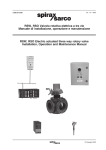
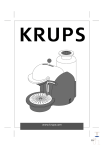
![Delibera n. 1543 del 24 dicembre 2014, [file]](http://vs1.manualzilla.com/store/data/006103206_1-ffd545e217dddb08d44f56ea7bf237f7-150x150.png)
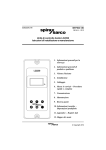
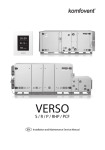
![Delibera n. 0987 del 12 agosto 2014, [file]](http://vs1.manualzilla.com/store/data/006108852_1-32b52cfe2cc0725a2325d47d9b52251a-150x150.png)
